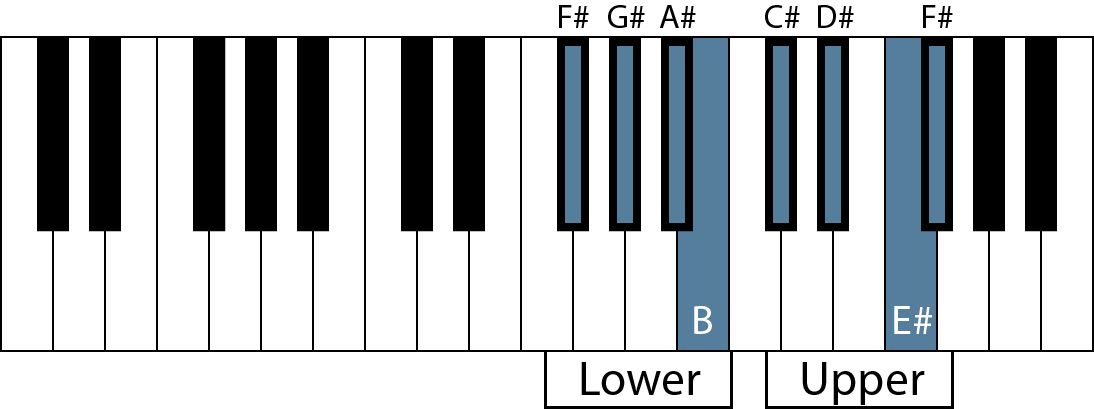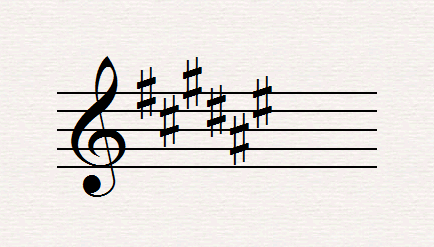F Sharp Major Scale

The F sharp major scale consists of the following notes:
F# G# A# B C# D# E#
There are 7 different notes in the scale. When the scale is played, the first note is usually repeated at the end, one octave higher. In this case, that’s the note F#. This kind of “rounds off” the scale, and makes it sound complete. Therefore, the final F# will sometimes be included in examples and diagrams, depending on the situation.
Here’s what it sounds like:
Scale Position
Each note has its own specific position within the scale. For example, G# is the 2nd note, or degree, of the scale. B is the 4th degree, and so on. The chart below shows the position of each note within the scale:

You may have noticed that the 7th degree of the scale is the relatively uncommon note E#. Even though E# is just another name for the note F (as we learned in the lesson on enharmonics), it’s important in this case to call the note E#, not F. This is because we already have an F note in the scale, F#, and we can’t have an F# and an F natural in the same major scale. Every degree of the scale gets its own letter, and its own space or line on the staff.
This way we can quickly recognize which degree of the scale we’re looking at on a piece of music, at a glance. It would be much more confusing if two of the scale degrees shared the same exact line or space!
Sharps And Flats
The F sharp major scale contains 6 sharps: F#, G#, A#, C#, D#, and E#.
The scale of a piece of music is usually indicated by a key signature, a symbol that flattens or sharpens specific lines or spaces on the staff. Instead of putting a sharp symbol next to every single F, G, A, C, D, and E notes, it’s much easier to just place a key signature at the beginning of the music, which automatically sharps every F, G, A, C, D, and E, so that the music conforms to the F sharp scale.
So in this case, the key signature is 6 sharps, and it looks like this:
F Sharp Major Scale On the Piano
It’s an excellent skill to be able to quickly and easily visualize scales on the piano. The key to doing this is focusing on which white keys and which black keys are part of the scale. Also, we have to keep in mind the two zones that make up each octave register on the keyboard.
Scale visualization for F sharp major:
white keys: B and E# (the first and last white notes in Zone 2)
black keys: all
Here’s what it looks like (spanning one octave):

And here it is with the scale degrees indicated:

Notice the unique major scale pattern: Whole, whole, half; whole, whole, whole, half.
All scales are infinite – they go on forever in both directions. The diagrams above show the scale over one octave, but keep in mind that this same pattern repeats itself across the keyboard.
Put It In Writing
Now we will take a look at the F sharp major scale in music notation. Here it is in all 4 commonly used clefs – treble, bass, alto and tenor:




The rest of the notation examples will be shown in treble clef, but all the examples are provided for reference in the others 3 clefs as well at the end of this lesson.
The next example shows the notes of the scale, along with the note names and scale degree numbers:

And here is one more example displaying the unique major scale pattern:

Solfege Syllables
Solfege is a musical system that assigns specific syllables to each scale degree, allowing us to sing the notes of the scale and learn the unique, individual sound of each one. It’s a great way to train your ears to know what you’re hearing!
The following chart shows the solfege syllables for each note in the F sharp major scale:

Here are the solfege syllables on piano:

And in music notation:

Tetrachords
All major scales can be split in half, into two major tetrachords (a 4-note segment with the pattern 2-2-1, or whole-step, whole-step, half-step). It’s much easier to remember 4-note patterns than 7 or 8-note patterns, so breaking it down into two parts can be very helpful.
The lower tetrachord of F sharp major is made up of the notes F#, G#, A#, and B.
The upper tetrachord is made up of the notes C#, D#, E#, and F#.
These two 4-note segments are joined by a whole-step in the middle.
It’s helpful to see this on a piano diagram:

And here they are in music notation:

Traditional Scale Degree Names
In traditional harmony, special names are given to each scale degree. A lot of harmony textbooks use these names, so they’re useful to know.
Here’s a chart of the scale degree names for the F sharp major scale:

And here’s an example in music notation:

Finally, here’s a chart showing scale degree numbers, solfege syllables, and traditional scale degree names, all in one, to clarify the relationship between all these:

Notation Examples In Bass Clef
All the notation examples used in this lesson are provided below in the other three clefs, beginning with bass clef:





Notation Examples In Alto Clef
Here are the notation examples for alto clef:





Notation Examples In Tenor Clef
The final set of examples, for tenor clef:





Practice Quiz
F Sharp Major Scale Quiz
Test your knowledge of this lesson with the following quiz:
Image Attribution:
practice makes perfect. by Jukie Bot ©2013 CC by 2.0
